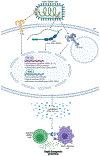Therapeutic vaccination strategies against EBOV by rVSV-EBOV-GP: the role of innate immunity
- PMID: 34749265
- PMCID: PMC8884032
- DOI: 10.1016/j.coviro.2021.10.007
Therapeutic vaccination strategies against EBOV by rVSV-EBOV-GP: the role of innate immunity
Abstract
Zaire Ebola virus (EBOV) is a member of the Filoviridae family. Infection with EBOV causes Ebola virus disease (EVD) characterized by excessive inflammation, lymphocyte death, coagulopathy, and multi-organ failure. In 2019, the FDA-approved the first anti-EBOV vaccine, rVSV-EBOV-GP (Ervebo® by Merck). This live-recombinant vaccine confers both prophylactic and therapeutic protection to nonhuman primates and humans. While mechanisms conferring prophylactic protection are well-investigated, those underlying protection conferred shortly before and after exposure to EBOV remain poorly understood. In this review, we review data from in vitro and in vivo studies analyzing early immune responses to rVSV-EBOV-GP and discuss the role of innate immune activation in therapeutic protection.
Copyright © 2021 The Author(s). Published by Elsevier B.V. All rights reserved.
Figures

Similar articles
-
Distinct Immunogenicity and Efficacy of Poxvirus-Based Vaccine Candidates against Ebola Virus Expressing GP and VP40 Proteins.J Virol. 2018 May 14;92(11):e00363-18. doi: 10.1128/JVI.00363-18. Print 2018 Jun 1. J Virol. 2018. PMID: 29514907 Free PMC article.
-
Antiviral Innate Responses Induced by VSV-EBOV Vaccination Contribute to Rapid Protection.mBio. 2019 May 28;10(3):e00597-19. doi: 10.1128/mBio.00597-19. mBio. 2019. PMID: 31138743 Free PMC article.
-
To B or Not to B: Mechanisms of Protection Conferred by rVSV-EBOV-GP and the Roles of Innate and Adaptive Immunity.Microorganisms. 2020 Sep 25;8(10):1473. doi: 10.3390/microorganisms8101473. Microorganisms. 2020. PMID: 32992829 Free PMC article. Review.
-
Rapid Protection from COVID-19 in Nonhuman Primates Vaccinated Intramuscularly but Not Intranasally with a Single Dose of a Vesicular Stomatitis Virus-Based Vaccine.mBio. 2022 Feb 22;13(1):e0337921. doi: 10.1128/mbio.03379-21. Epub 2022 Jan 11. mBio. 2022. PMID: 35012339 Free PMC article.
-
Immunology of protection from Ebola virus infection.Sci Transl Med. 2015 May 6;7(286):286ps11. doi: 10.1126/scitranslmed.aaa8202. Sci Transl Med. 2015. PMID: 25947159 Review.
Cited by
-
Oral Immunization with rVSV Bivalent Vaccine Elicits Protective Immune Responses, Including ADCC, against Both SARS-CoV-2 and Influenza A Viruses.Vaccines (Basel). 2023 Aug 23;11(9):1404. doi: 10.3390/vaccines11091404. Vaccines (Basel). 2023. PMID: 37766083 Free PMC article.
-
Safety and immunogenicity of GamEvac-Combi, a heterologous rVSV- and rAd5-vectored Ebola vaccine: a randomized controlled multicenter clinical trial in the Republic of Guinea and Russia.Front Immunol. 2025 Mar 20;16:1487039. doi: 10.3389/fimmu.2025.1487039. eCollection 2025. Front Immunol. 2025. PMID: 40207235 Free PMC article. Clinical Trial.
References
Publication types
MeSH terms
Substances
Grants and funding
LinkOut - more resources
Full Text Sources
Medical

